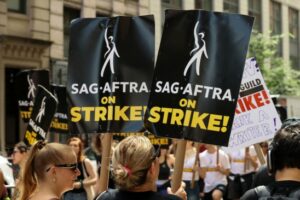With the writers’ and actors’ strikes now poised to continue through possibly the end of the year, entertainment executives are scrambling to limit the fallout. The more traditional companies may take the bigger hitting the near term, with production delayed on their fall lineups and advertising dollars in jeopardy, as a result. Streamers like Netflix and Max are safer, with their extensive back catalogs of content that can keep audiences amused for the time being. “They are now the beneficiary of the final destruction of the old model,” says Barry Diller, the former Paramount and Fox executive who now heads up IAC.
- Netflix added almost 6 million subscribers and saw a 3% revenue boost in the second quarter, the company announced Wednesday.
By Emma W. Thorne, Editor at LinkedIn News
Why SAG-AFTRA’s Streaming Revenue Sharing Proposal for Casts Was Flatly Rejected by AMPTP
The union would like performers “to share in the rewards of a successful show, without bearing any of the risk,” the group that lobbies for studios says.

The Alliance of Motion Picture and Television Producers, the group representing Hollywood studios and streamers in union negotiations, is offering its side of the story as to the deal the group offered SAG-AFTRA before the performers’ union went on strike.
In a 23-page document issued on Friday afternoon, the AMPTP responded to SAG-AFTRA’s version of events, provided in a July 17 chart of alleged union proposals and responses from management. “Substantial portions of that chart are misleading, either in the characterization of the Producers’ offer or in the omission of key details,” the group said. In its own chart of SAG-AFTRA proposals and AMPTP counter-offers, the group offered its take on the union’s asks and its responses, saying that the ultimate package it offered the union on July 12 was worth more than $1 billion in compensation and benefits increases.
The Hollywood Reporter has reached out to SAG-AFTRA for comment on the document.
One of SAG-AFTRA’s boldest proposals during its 2023 negotiations was that casts receive a cut of streamers’ subscriber revenues “generated when their [performers’] performances are exhibited on streaming platforms.” The AMPTP claimed that this proposal was discussed “numerous” times and “each time, the Producers emphasized that they had fundamental objections to the Union’s proposal, and asked that the proposal be removed, as it was serving as a roadblock to reaching an agreement.” According to the group, the proposal gives performers their usual fixed residuals for streaming projects “also a new residual which ‘shares’ in revenue that is somehow attributed to the show.” The group added, “the Union proposes to ‘share’ in success, but not in failure. That is not sharing.” (Of course, before streaming entertainment arrived, actors did share in success but did not in failure — if a project was a hit and re-used or re-run, those performers were compensated with residuals beyond their upfront payments, but were not penalized if the project did poorly.)
The group further claimed that because the AMPTP is a group of producers (some of whom are under the same corporate umbrella as distributors), the proposal does not “follow the money.” The AMPTP says, “The Union’s proposal creates a one-size-fits-all approach that ignores the relationship between program suppliers and exhibitors.”
On the key issue of basic wage increases, the union was seeking an 11 percent increase in the first year and 4 percent in years two and three, while the AMPTP offered a 5/4/3.5 percent combination. This offer, the AMPTP said, was “historic,” arguing that “the last time the Union secured a general wage increase of 5% in any year was in 1988.” According to the AMPTP, the producers’ proposal would offer $717 million in additional wage compensation, more than double the gains in SAG-AFTRA’s 2020 contract, which allegedly boosted wages by $305 million.
When it comes to the hot-button topic of A.I., SAG-AFTRA claimed that its proposal would “establish a comprehensive set of provisions to protect human-created work and require informed consent and fair compensation” when a member’s performance is ingested into an A.I.-powered system. According to the union, the AMPTP’s counter-offer “failed to address many vital concerns, leaving principal performers and background actors vulnerable to having most of their work replaced by digital replicas.”
The AMPTP disputed this characterization, saying that it offered a “comprehensive” proposal that the union ultimately never responded to. Some of its language, the group said, required companies to obtain consent to use a “digital replica” of a background actor “other than for the motion picture for which the background actor was hired.” The group also said it agreed not to use digital replicas of background actors instead of hiring the required number of background actors per SAG-AFTRA’s contract.
As for performers, the AMPTP argued it agreed to require consent to create a “digital replica” of that member and to “digitally alter the performance beyond typical alterations that have historically been done in post-production.” When a company wants to use a “digital replica” for a project other than the one that the performer agreed to, it “must obtain a performer’s consent and bargain separately,” the group claimed.
SAG-AFTRA has been on strike for a week since the union and the AMPTP failed to reach an agreement on Wednesday, July 12. The two sides have each blamed the other for the subsequent work stoppage of around 160,000 union members, which has shut down and delayed major productions that the ongoing Writers Guild of America strike hadn’t already impacted, such as Deadpool 3 and Mission: Impossible 8. The SAG-AFTRA strike is the union’s first in over 40 years, and marks the first “double strike” where performers and writers are both picketing film and TV companies in over 60 years.
BY KATIE KILKENNY, The Hollywood Reporter





